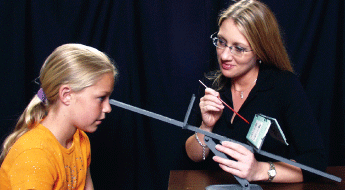Office-based vision therapy with follow-up exercises at home is more effective than home-based therapy alone when treating children with symptomatic convergence insufficiency (CI), according to new research.
Approximately 2.5% to 13% of children and adults in the
Before the trial was under way, the Convergence Insufficiency Treatment Trial (CITT) Study Group conducted two placebo-controlled, randomized pilot studies. One found that base-in prism glasses were no more effective than placebo reading glasses. The second study compared the effectiveness of home-based pencil push-ups, office-based vision therapy/orthoptics, and office-based placebo vision therapy/orthoptics, and found office-based vision therapy to be the most effective.
In the latest study, reported in the October 2008 issue of Archives of Ophthalmology and at last months annual meeting of the American Academy of Optometry, researchers at nine sites throughout the United States randomized 221 children with CI, ages 9 to 17 years, into four treatment groups: home-based pencil push-up therapy, home-based pencil push-up therapy with additional computer therapy, one-hour sessions of office-based vergence/accommodative therapy with a trained therapist and 15-minute at-home reinforcement exercises, and office-based placebo therapy with a trained therapist and 15-minute at-home reinforcement exercises.
After 12 weeks of treatment, nearly 75% of children who were given the office-based vision therapy along with at-home reinforcement achieved normal vision or had significantly fewer symptoms of CI, as measured by a mean Convergence Insufficiency Symptom Survey (CISS) score of 15.1 (a score of less than 16 is considered asymptomatic). This group also demonstrated a significantly improved near point of convergence and positive fusional vergence ranges at near compared with the other groups.
Photo courtesy: Susan Cotter, O.D., M.S.

Nearly 75% of children who underwent office-based vision therapy in conjunction with at-home reinforcement demonstrated normal vision or significantly fewer CI symptoms.
Only 43% of patients who completed home-based therapy alone showed similar results, as did 33% of patients who used home-based pencil push-ups plus computer therapy and 35% who performed in-office placebo therapy. CISS scores for these groups were 24.7, 21.3 and 21.9, respectively.
This study is particularly important because it showed that treatment can significantly reduce symptoms associated which CI when a child reads, which may improve reading performance.
This study shows that, once diagnosed, CI can be successfully treated with office-based vision therapy by a trained therapist along with at-home reinforcement. This is very encouraging news for parents, educators and anyone else who may know a child with CI, says principal investigator Mitchell Scheiman, O.D., of Pennsylvania College of Optometry at
More encouraging news: We found decreases in the frequency and severity of symptoms that might make schoolwork more difficult, Dr. Scheiman says. Parents reported that they saw a significant decrease in their child having difficulty completing schoolwork at school or at home, appearing inattentive or easily distracted when completing schoolwork, and avoiding schoolwork. In addition, parents reported that they worried less about their childs school performance.
The researchers caution, however, that these results do not show the long-term benefits. Specifically, they say that longer treatment may produce changes in signs and symptoms in the home-based treatment groups. For that reason, a 12-month follow-up study is being conducted to examine the long-term effects of these CI treatments.
Another caution: When translating these study results into clinical practice, it is important to recognize that they can only be applied to children with symptomatic CI who are aged 9 to 17 years, the researchers write. Adults with symptomatic CI may respond differently, as suggested by our pilot study.
The clinical take home is that it is incumbent upon optometrists who wish to practice evidence-based eye care to educate parents that the most effective treatment for a child with symptomatic convergence insufficiency is weekly office-based vergence/accommodative vision therapy with home reinforcement, says study co-chair Susan Cotter, O.D., M.S., of Southern California College of Optometry. Optometrists who do not provide this type of vision therapy in their offices can simply comanage the patient with a local optometrist who does. Incorporating a new treatment modality within a clinical practice requires an investment of education and training, time and equipment.
Another issue: For some parents, the cost of treatment may be prohibitive, Dr. Cotter says. However, parents must make their own decisions based upon the information given to them, their own personal goals and values, and their financial situation. Hopefully, the results of the CITT will encourage more insurance companies to provide coverage for children with symptomatic convergence insufficiency.

